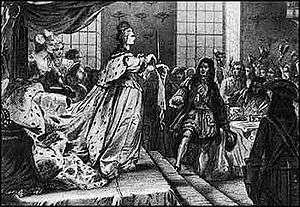Conditions (Russia)
The Conditions (Russian: Кондиции, Konditsii) were an 18th-century constitutional project in Russia, signed by Empress Anna of Russia in Mitau on 18 January 1730, giving substantial power to the Supreme Privy Council. When the Empress returned to Russia, she revoked her approval of the Conditions and dissolved the Supreme Privy Council on the 20th of February. The members of the Council were removed from government and exiled or repressed paving the way for Anna to become an absolute monarch in the model of her uncle Peter the Great.

Core of the Document
In the period January 18 (29) to January 20 (31), 1730 the members of the Supreme Privy Council compiled the conditions: immediately after the death of Peter II and before they were sent to the capital of Kurland, Mitava to be presented to Anna of Russia, who had been elected the inheritress of the Russian throne.
A curious feature of the Condition is that the document remained unpublished by the high officials “verhovniki”. The majority of the nobility could only guess about its content –by the time when the conditions have been presented at the meeting of the officials held on February 2 (13), 1730. Only since this moment on, among the Russian nobility, there was an obvious split - which led, in particular, to the appearance of programs of the noble opposition.
The Conditions, according to contemporaries, was only a preliminary document, a squeeze of the more extensive radical plan developed by the Prince Golitsyn, however, not approved within the Secret Council. Not having come to an internal agreement, the high officials “verhoniki" did not propose their own draft of the future state structure, but suggested to the nobility to develop it by themselves when the nobility were gathered in Moscow to draw up the next Ulozhenanaya Commission and to the failed wedding ceremony of the Peter II.
There were seven major drafts, and none of them provided the absolutism preservation. Some proposed to limit the monarch power by the parliament or by the state council according to the English or Swedish model (to which Golitsyn’s project belonged), others to make the emperor elective, as in Poland, some proposed to establish an aristocratic republic. The most popular project, which was supported by 364 people, sometimes named Cherkassky-Tatishchev project, envisaged to establish the “Higher Government” of 21 people and introduce the election of members of this government, senators, governors and presidents of colleges by the second chamber of 100 people. By this project, the Supreme Secret Council was abolished, so the majority of the higher officials “verhovniki” were against it.
Dmitry Golitsyn, the main author of Conditions, did not directly report that the power of the Supreme Secret Council was temporary, as a result, the majority of the high-ranking officials, as well as many young lower officers, thought that Golitsyn and the Supreme Secret Council wanted to usurp power. All these misinterpretations were aggravated by the absolutist propaganda done by Theophan Prokopovich.
The nobility began to oppose the Conditions. When Anna Ivanovna came in Moscow, noble delegations came to her, demanding that she abolish the Conditions and return to absolutism.
Content
The Conditions acted as a constitution binding the monarch in relation to:
- Declarations of War.
- Signing of Treaties.
- Imposing new taxes.
- Appointing officers to ranks higher than Polkovnik (Colonel).
.jpg)
- Depriving and granting estates.
- Appointing to the court ranks.
- Using of public revenues.
None of these powers could be exercised by the monarch, under the Conditions, without the approval of the Supreme Privy Council. Or else they would face the possibility of deposition.